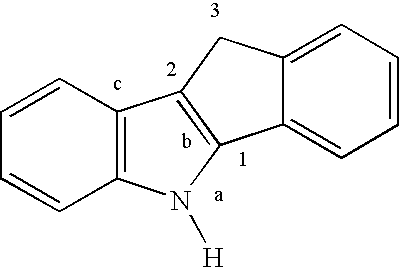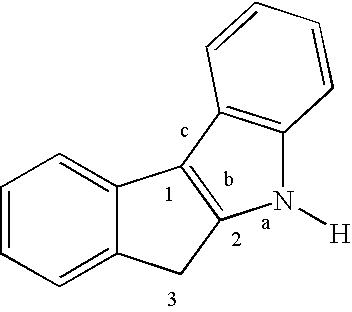Olefin polymerization process
a polymerization process and olefin technology, applied in the field of olefin polymerization process, can solve the problems of low activity and poor incorporation of a-olefin comonomers, and achieve the effect of boosting catalyst activity and polyolefin molecular weigh
- Summary
- Abstract
- Description
- Claims
- Application Information
AI Technical Summary
Benefits of technology
Problems solved by technology
Method used
Image
Examples
example 1
Synthesis of 1,1-bis[6-(2,5-dimethyl-5,6-dihydro-indeno[2,1-b])indolyl]methane zirconium dichloride, 1-4
(a) Preparation of 5,6-dihydro-2-methyl-indeno[2,1-b]indole 1-1. A mixture of 2-indanone (51.0 g, 0.39 mol) and p-tolylhydrazine hydrochloride (61.4 g, 0.39 mol) is dissolved in glacial acetic acid (525 mL) and is vigorously stirred and heated to reflux. The mixture turns red and is heated for 2 hours. After cooling to room temperature, it is poured into ice water (1 L). The precipitate is filtered to afford a solid, which is washed with water (about 1 L). The solid is dissolved in ethyl acetate (1.4 L), activated charcoal is added, and the mixture is gently warmed. The mixture is then cooled and filtered over a pad of Celite. The filtrate is dried over sodium sulfate, filtered, and is then concentrated to 450 mL and cooled to −30° C. for 3 days. The crystalline solid is filtered and washed with chilled (−78° C.) hexanes (2×500 mL). The beige solid is collected and dried under v...
example 2
Preparation of Catalyst Supported on Diethylzinc-Treated Silica
In a glove-box under nitrogen, 2.0 mL of 1.0 M diethylzinc in heptane is mixed with 2.00 g of G955 silica (available from Grace Davison) having a surface area (BET) of 280-355 m2 / g and a pore volume of 1.55-2.00 mL / g that had been calcined at 250° C. After mixing at room temperature for about 0.5 hour, volatiles are removed by vacuum to obtain 2.30 g of diethylzinc treated silica.
1.8 mL of 30% by weight methylalumoxane (MAO) in toluene is diluted by mixing with 3.6 mL toluene. Complex 1-4 (13.8 mg, 0.019 mmole) is mixed with the diluted MAO solution to make a deep green-blue solution. This green-blue solution is mixed further with 1.00 g of diethylzinc treated silica prepared above. After stirring for 30 minutes at room temperature, the volatiles are removed by vacuum to obtain 1.68 g of the supported catalyst as a dark green powder.
example 4
shows that by treating a support with an organozinc compound, the catalyst activity is increased, the molecular weight is increased and MI is decreased versus Comparative Example 5.
PUM
| Property | Measurement | Unit |
|---|---|---|
| temperature | aaaaa | aaaaa |
| structure | aaaaa | aaaaa |
| valence | aaaaa | aaaaa |
Abstract
Description
Claims
Application Information
 Login to View More
Login to View More - R&D
- Intellectual Property
- Life Sciences
- Materials
- Tech Scout
- Unparalleled Data Quality
- Higher Quality Content
- 60% Fewer Hallucinations
Browse by: Latest US Patents, China's latest patents, Technical Efficacy Thesaurus, Application Domain, Technology Topic, Popular Technical Reports.
© 2025 PatSnap. All rights reserved.Legal|Privacy policy|Modern Slavery Act Transparency Statement|Sitemap|About US| Contact US: help@patsnap.com



